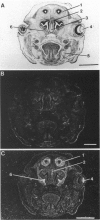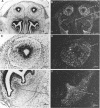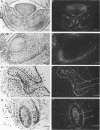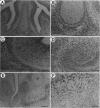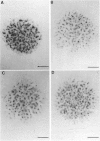Abstract
To explore the possible role of transforming growth factor alpha (TGF-alpha) in craniofacial development, its expression in the craniofacial region of rat embryos from embryonic day (d) 9 to d 20 was examined by in situ hybridisation and immunostaining. The TGF-alpha transcripts were first detected in the neural fold of embryonic d 9 and 10 embryos. In the craniofacial region, the TGF-alpha transcripts were not detected until embryonic d 16 in mesenchyme surrounding the olfactory bulb, within the olfactory bulb, the nasal capsule, vomeronasal organ, and vibrissal follicle. In addition, TGF-alpha message was detected in mesenchyme in the vicinity of Meckel's cartilage, and in the dental epithelium and lamina. This expression pattern of TGF-alpha transcripts persisted until embryonic d 17 but disappeared by d 18. The presence of TGF-alpha protein largely coincided with TGF-alpha message although, unlike the message, it persisted throughout later embryogenesis in the craniofacial region. The possible function of TGF-alpha in chondrogenesis was explored by employing the micromass culture technique. Cartilage nodule formation in mesenchymal cells cultured from rat mandibles in the presence of TGF-alpha was significantly inhibited. This inhibitory effect of TGF-alpha on chondrogenesis was reversed by addition of antibody against the EGF receptor, which crossreacts with the TGF-alpha receptor. The inhibitory effect of TGF-alpha on chondrogenesis in vitro was further confirmed by micromass culture using mesenchymal cells from rat embryonic limb bud. Taken together, these results demonstrate the involvement of TGF-alpha in chondrogenesis during embryonic development, possibly by way of a specific inhibition of cartilage formation from mesenchymal precursor cells.
Full text
PDF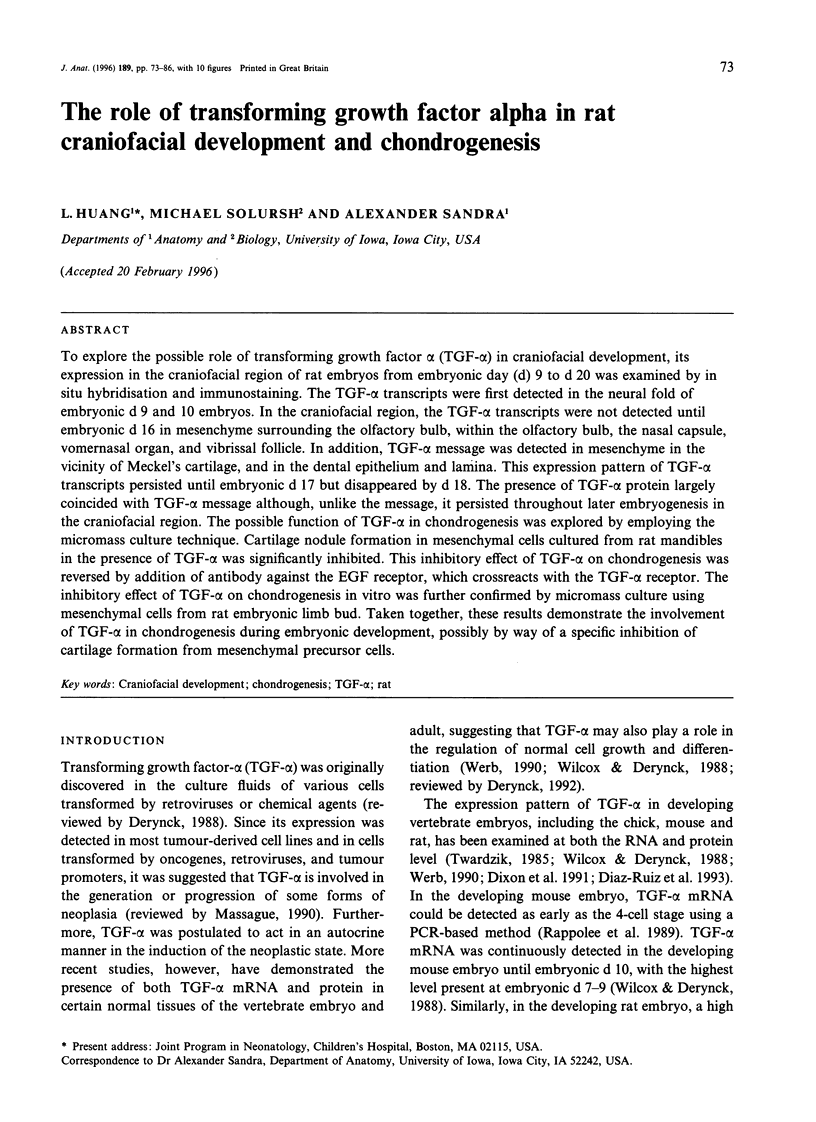
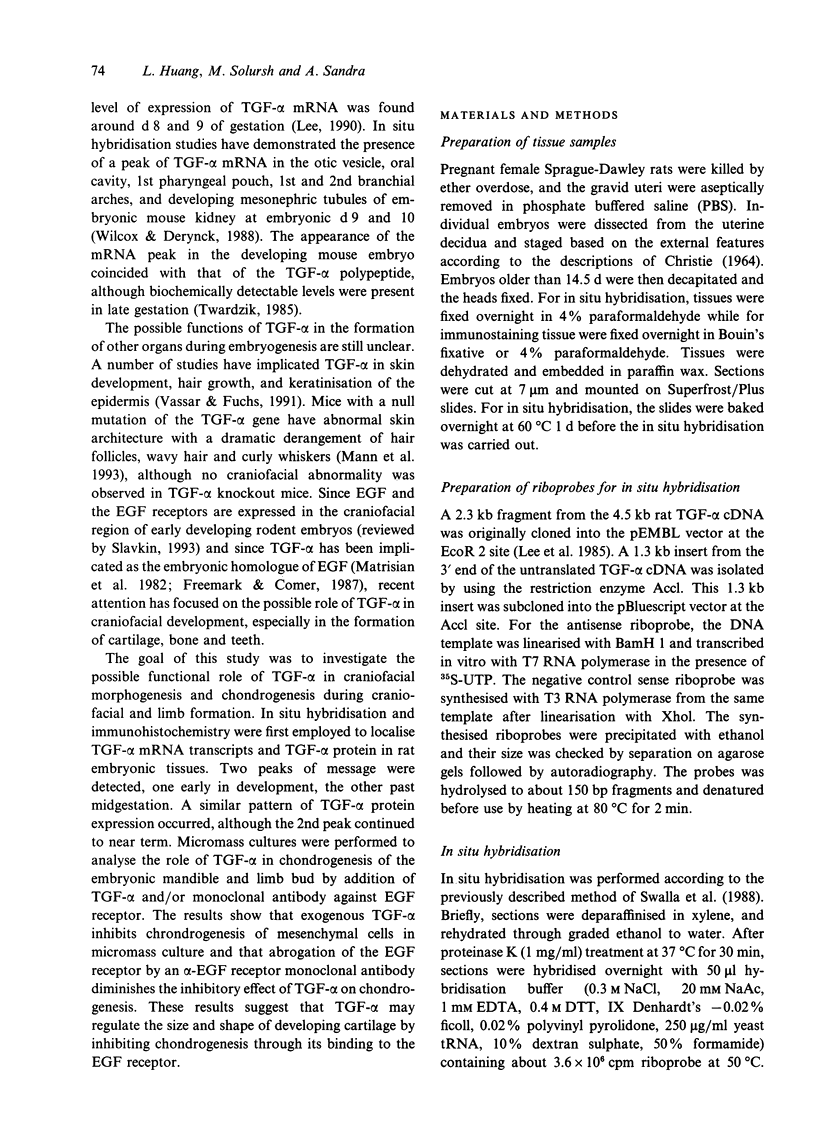
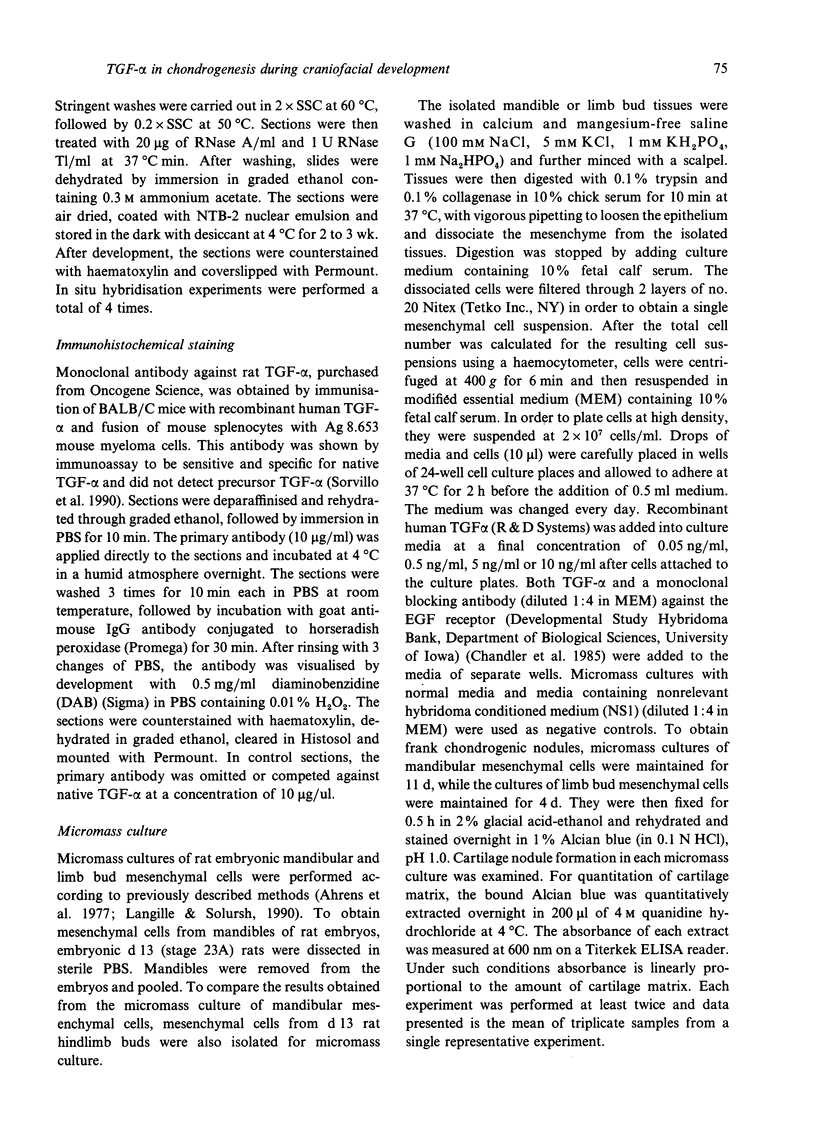


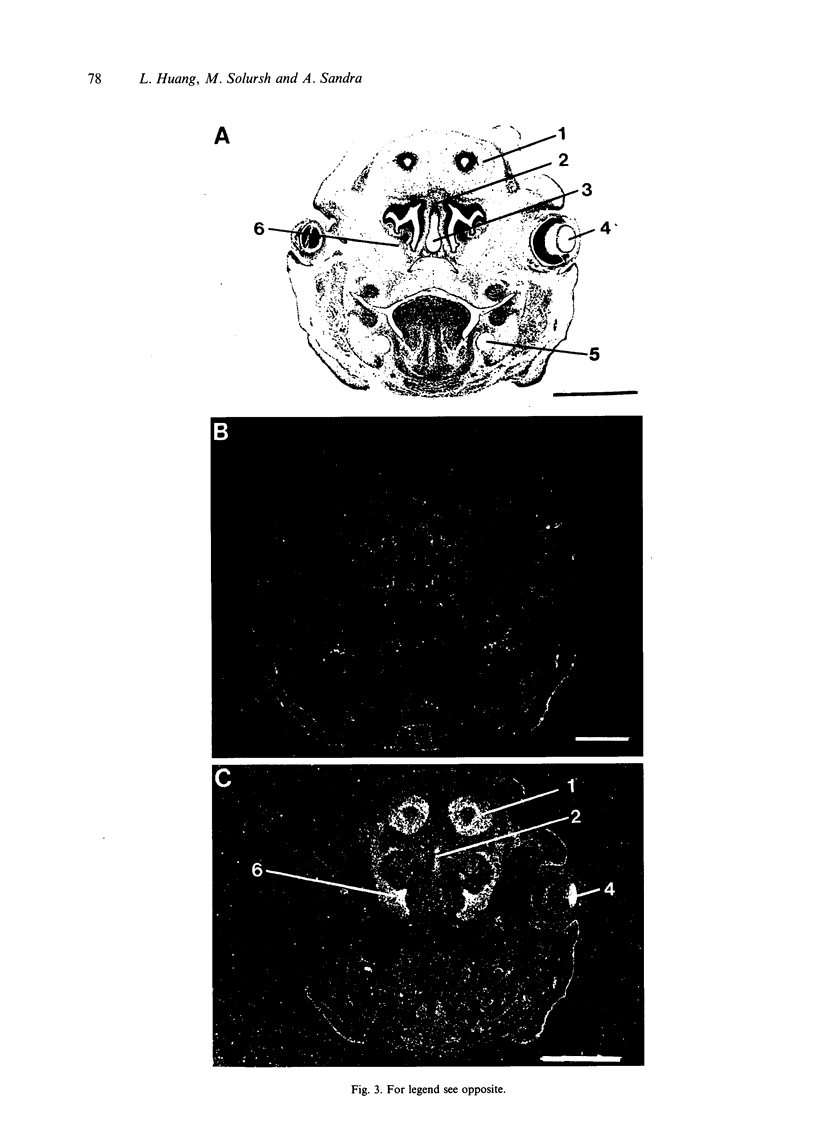

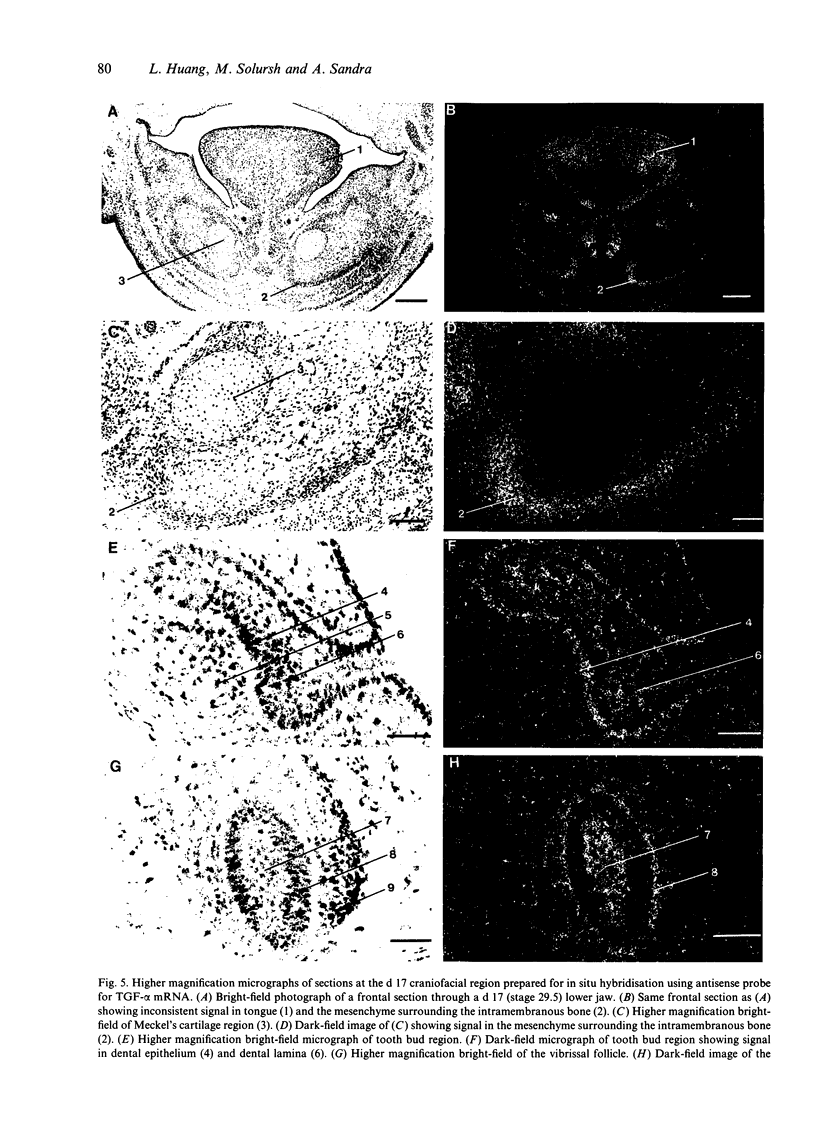

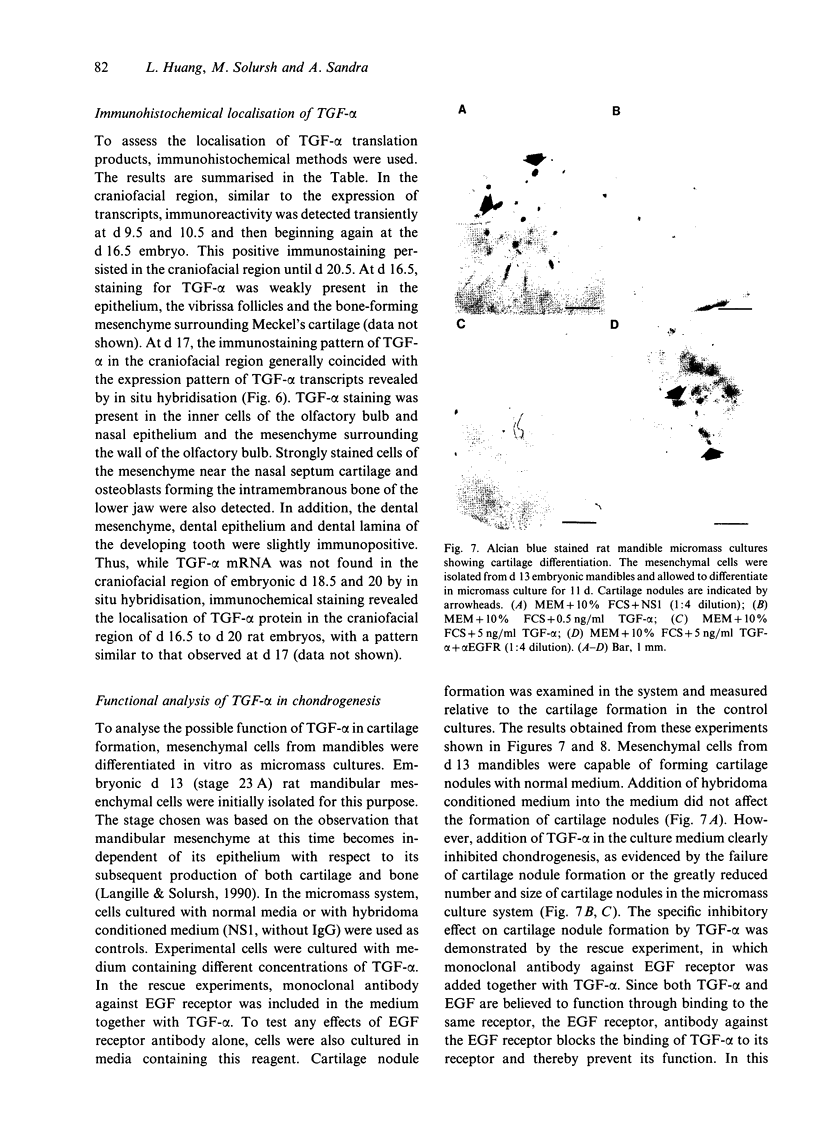
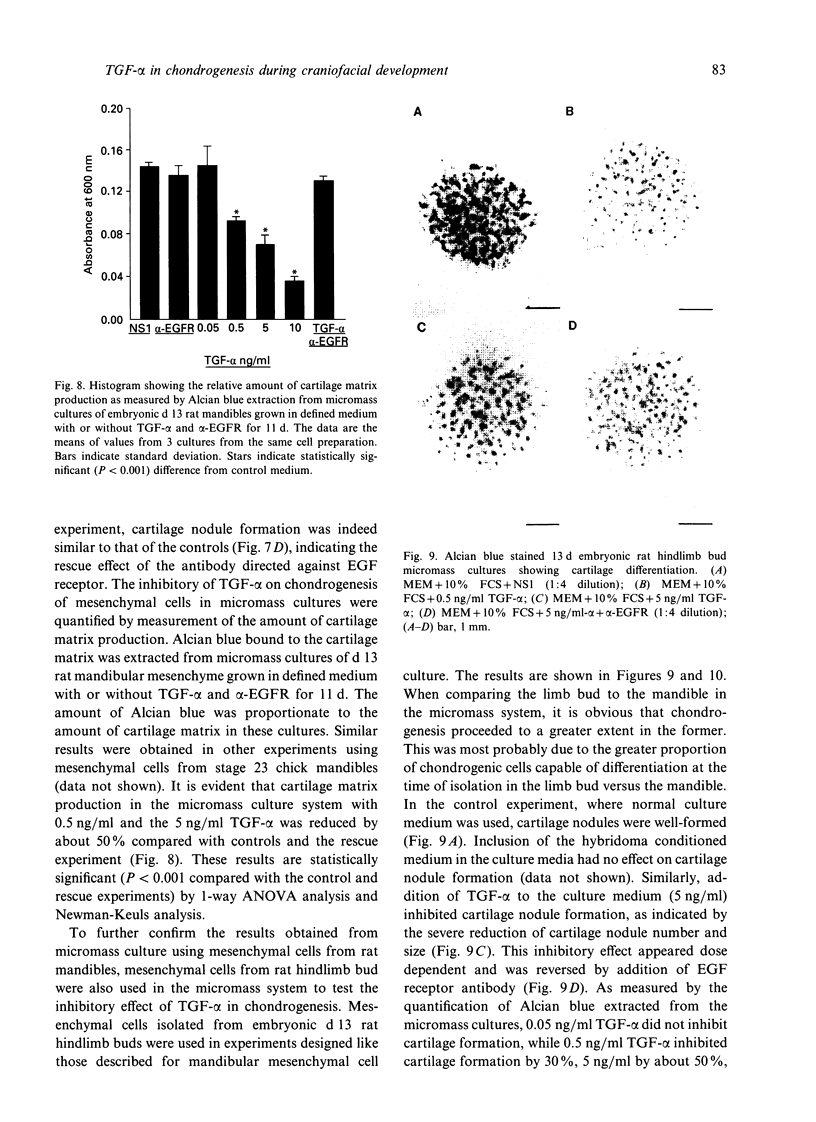



Images in this article
Selected References
These references are in PubMed. This may not be the complete list of references from this article.
- Ahrens P. B., Solursh M., Reiter R. S. Stage-related capacity for limb chondrogenesis in cell culture. Dev Biol. 1977 Oct 1;60(1):69–82. doi: 10.1016/0012-1606(77)90110-5. [DOI] [PubMed] [Google Scholar]
- CHRISTIE G. A. DEVELOPMENTAL STAGES IN SOMITE AND POST-SOMITE RAT EMBRYOS, BASED ON EXTERNAL APPEARANCE, AND INCLUDING SOME FEATURES OF THE MACROSCOPIC DEVELOPMENT OF THE ORAL CAVITY. J Morphol. 1964 Mar;114:263–283. doi: 10.1002/jmor.1051140207. [DOI] [PubMed] [Google Scholar]
- Chandler L. P., Chandler C. E., Hosang M., Shooter E. M. A monoclonal antibody which inhibits epidermal growth factor binding has opposite effects on the biological action of epidermal growth factor in different cells. J Biol Chem. 1985 Mar 25;260(6):3360–3367. [PubMed] [Google Scholar]
- Coffin-Collins P. A., Hall B. K. Chondrogenesis of mandibular mesenchyme from the embryonic chick is inhibited by mandibular epithelium and by epidermal growth factor. Int J Dev Biol. 1989 Jun;33(2):297–311. [PubMed] [Google Scholar]
- Derynck R. The physiology of transforming growth factor-alpha. Adv Cancer Res. 1992;58:27–52. doi: 10.1016/s0065-230x(08)60289-4. [DOI] [PubMed] [Google Scholar]
- Derynck R. Transforming growth factor alpha. Cell. 1988 Aug 26;54(5):593–595. doi: 10.1016/s0092-8674(88)80001-1. [DOI] [PubMed] [Google Scholar]
- Derynck R. Transforming growth factor-alpha: structure and biological activities. J Cell Biochem. 1986;32(4):293–304. doi: 10.1002/jcb.240320406. [DOI] [PubMed] [Google Scholar]
- Dixon M. J., Garner J., Ferguson M. W. Immunolocalization of epidermal growth factor (EGF), EGF receptor and transforming growth factor alpha (TGF alpha) during murine palatogenesis in vivo and in vitro. Anat Embryol (Berl) 1991;184(1):83–91. doi: 10.1007/BF01744264. [DOI] [PubMed] [Google Scholar]
- Freemark M., Comer M. Epidermal growth factor (EGF)-like transforming growth factor (TGF) activity and EGF receptors in ovine fetal tissues: possible role for TGF in ovine fetal development. Pediatr Res. 1987 Nov;22(5):609–615. doi: 10.1203/00006450-198711000-00026. [DOI] [PubMed] [Google Scholar]
- Han V. K., Hunter E. S., 3rd, Pratt R. M., Zendegui J. G., Lee D. C. Expression of rat transforming growth factor alpha mRNA during development occurs predominantly in the maternal decidua. Mol Cell Biol. 1987 Jul;7(7):2335–2343. doi: 10.1128/mcb.7.7.2335. [DOI] [PMC free article] [PubMed] [Google Scholar]
- Langille R. M., Solursh M. Formation of chondrous and osseous tissues in micromass cultures of rat frontonasal and mandibular ectomesenchyme. Differentiation. 1990 Sep;44(3):197–206. doi: 10.1111/j.1432-0436.1990.tb00618.x. [DOI] [PubMed] [Google Scholar]
- Lee D. C., Rose T. M., Webb N. R., Todaro G. J. Cloning and sequence analysis of a cDNA for rat transforming growth factor-alpha. Nature. 1985 Feb 7;313(6002):489–491. doi: 10.1038/313489a0. [DOI] [PubMed] [Google Scholar]
- Lee D. C. TGF-alpha: expression and biological activities of the integral membrane precursor. Mol Reprod Dev. 1990 Sep;27(1):37–45. doi: 10.1002/mrd.1080270109. [DOI] [PubMed] [Google Scholar]
- Mann G. B., Fowler K. J., Gabriel A., Nice E. C., Williams R. L., Dunn A. R. Mice with a null mutation of the TGF alpha gene have abnormal skin architecture, wavy hair, and curly whiskers and often develop corneal inflammation. Cell. 1993 Apr 23;73(2):249–261. doi: 10.1016/0092-8674(93)90227-h. [DOI] [PubMed] [Google Scholar]
- Massagué J. Epidermal growth factor-like transforming growth factor. II. Interaction with epidermal growth factor receptors in human placenta membranes and A431 cells. J Biol Chem. 1983 Nov 25;258(22):13614–13620. [PubMed] [Google Scholar]
- Massagué J. Transforming growth factor-alpha. A model for membrane-anchored growth factors. J Biol Chem. 1990 Dec 15;265(35):21393–21396. [PubMed] [Google Scholar]
- Matrisian L. M., Pathak M., Magun B. E. Identification of an epidermal growth factor-related transforming growth factor from rat fetuses. Biochem Biophys Res Commun. 1982 Aug;107(3):761–769. doi: 10.1016/0006-291x(82)90589-7. [DOI] [PubMed] [Google Scholar]
- Pike L. J., Marquardt H., Todaro G. J., Gallis B., Casnellie J. E., Bornstein P., Krebs E. G. Transforming growth factor and epidermal growth factor stimulate the phosphorylation of a synthetic, tyrosine-containing peptide in a similar manner. J Biol Chem. 1982 Dec 25;257(24):14628–14631. [PubMed] [Google Scholar]
- Rappolee D. A., Wang A., Mark D., Werb Z. Novel method for studying mRNA phenotypes in single or small numbers of cells. J Cell Biochem. 1989 Jan;39(1):1–11. doi: 10.1002/jcb.240390102. [DOI] [PubMed] [Google Scholar]
- Shum L., Sakakura Y., Bringas P., Jr, Luo W., Snead M. L., Mayo M., Crohin C., Millar S., Werb Z., Buckley S. EGF abrogation-induced fusilli-form dysmorphogenesis of Meckel's cartilage during embryonic mouse mandibular morphogenesis in vitro. Development. 1993 Jul;118(3):903–917. doi: 10.1242/dev.118.3.903. [DOI] [PubMed] [Google Scholar]
- Slavkin H. C. Rieger syndrome revisited: experimental approaches using pharmacologic and antisense strategies to abrogate EGF and TGF-alpha functions resulting in dysmorphogenesis during embryonic mouse craniofacial morphogenesis. Am J Med Genet. 1993 Oct 1;47(5):689–688. doi: 10.1002/ajmg.1320470521. [DOI] [PubMed] [Google Scholar]
- Sorvillo J. M., McCormack E. S., Yanez L., Valenzuela D., Reynolds F. H., Jr Preparation and characterization of monoclonal antibodies specific for human transforming growth factor alpha. Oncogene. 1990 Mar;5(3):377–386. [PubMed] [Google Scholar]
- Swalla B. J., Upholt W. B., Solursh M. Analysis of type II collagen RNA localization in chick wing buds by in situ hybridization. Dev Biol. 1988 Jan;125(1):51–58. doi: 10.1016/0012-1606(88)90057-7. [DOI] [PubMed] [Google Scholar]
- Werb Z. Expression of EGF and TGF-alpha genes in early mammalian development. Mol Reprod Dev. 1990 Sep;27(1):10–15. doi: 10.1002/mrd.1080270105. [DOI] [PubMed] [Google Scholar]
- Wilcox J. N., Derynck R. Developmental expression of transforming growth factors alpha and beta in mouse fetus. Mol Cell Biol. 1988 Aug;8(8):3415–3422. doi: 10.1128/mcb.8.8.3415. [DOI] [PMC free article] [PubMed] [Google Scholar]





